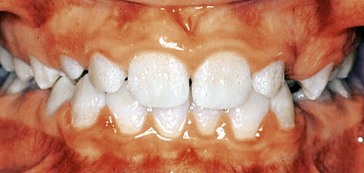37 Amelogenesis imperfecta
History
 Were the primary teeth similarly affected?
Were the primary teeth similarly affected?
There was a slight roughening of the primary teeth, although nothing as bad as the permanent teeth.
 Is anyone else in the family similarly affected?
Is anyone else in the family similarly affected?
Mark’s father and his cousin (father’s brother’s son) have similar roughness of their teeth.
After having obtained this history it is most likely that Mark has an inherited enamel defect involving enamel – amelogenesis imperfecta. However, defective enamel formation may be caused by genetic or environmental factors. The defective enamel will exhibit either hypoplasia, due to deficient matrix production, or hypomineralization, from imperfect mineralization of the matrix proteins. In hypoplasia the enamel may be thin, grooved or pitted, whereas in hypomineralization it may appear mottled but of normal thickness. The complete range of the causes of developmental abnormalities of enamel are shown in Box 37.1.
Examination
Intraoral examination revealed that all the surfaces of all the erupted permanent teeth are affected by a roughness or ‘pitting’ (Fig. 37.1). The second primary molar teeth that were still present were also affected by a similar roughness that, although not as evident on visual examination, was obvious on tactile examination with a probe. There was no tooth wear.
Stay updated, free dental videos. Join our Telegram channel

VIDEdental - Online dental courses






